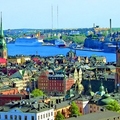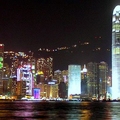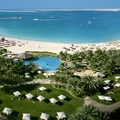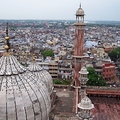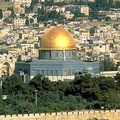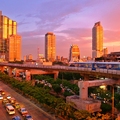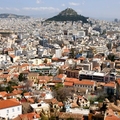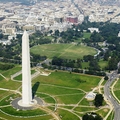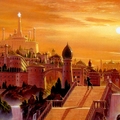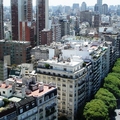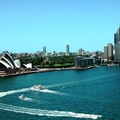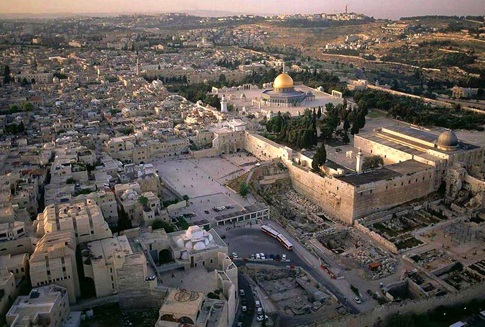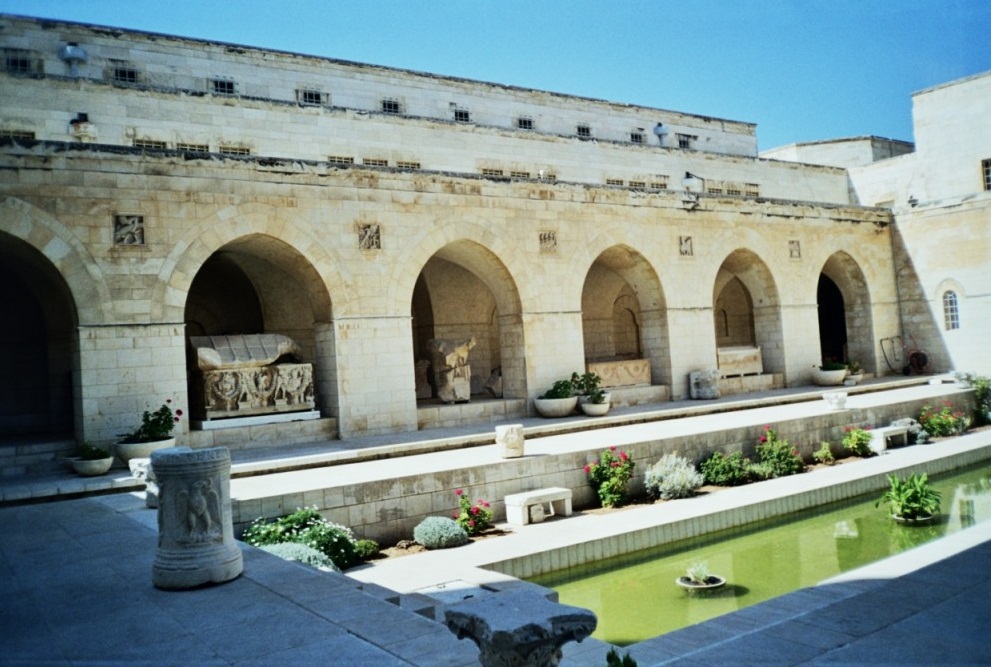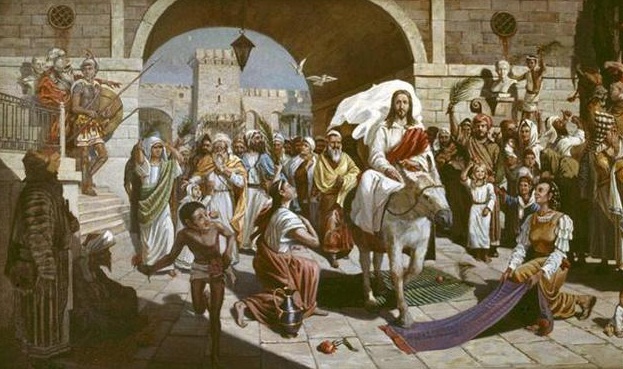Destinations / The best capital cities in the world / Jerusalem-the holy capital city of the world
Jerusalem-the holy capital city of the world
About Jerusalem
There is only a city in the world, the name of which is loudly uttered by different people from different countries, of different beliefs and of different color of the skin. Jerusalem is the only city in the world, that has more than seventy names given by people who express their love and commitment to it. Jerusalem is not just a city where people live in houses, where they work, fall in love, marry, where people are born and die .This is the most mysterious place on the Earth. This city fascinates ,charms, and attracts. Who goes there once, wants to go again and again. Jerusalem should not be seen, but felt. This is the place where you lose the sense of reality, where the time combines with the eternity, where there is everything and at the same time there is nothing . On ancient maps, Jerusalem is depicted as the center of the world, and today it is a common sanctuary for Christians, Jews and Muslims. Over the millennia, it serves as a pretext for endless disputes and bloody wars. And yet, every year thousands of people from different countries and beliefs come here, believing themselves to be responsible for its fate.
Jerusalem is called the city of peace and it is a city of three religions. Such a fantastic mixture of history and of peoples, traditions and cultures, where churches, synagogues and mosques rule all together, you will not find anywhere else. As if the hand of the great masters are connecting some pieces of a beautiful painting, which is appended in front of you. Boys with paces, men dressed in black, hurrying to synagogues, Arabs asking you to buy something, soldiers with machine guns on the preponderance of tourists and pilgrims from all over the world, church bells ringing, the voice of the muezzin gathering believers to their prayers. All these taken together are contradictory and at the same time harmonious. You just have to contemplate and enjoy, amazed to see such wonderful place. You can spend entire hours wandering alone through the narrow winding streets, or wade through the crowds of tourists following the guide, turning their heads left and right at the sightseeing places of Jerusalem. If you make a trip to this city, you will never forget, because, once you set your foot on this land, you won’t remain the same. It gets into your soul relentlessly and so naturally that you feel that way forever.
History of Jerusalem
There have never been minerals to grow crops in the ancient capital of Israel , Jerusalem, and water to drink was not always enough, although armies of different nations have been fighting for this city for over 30 centuries. Jerusalem became the center of three religions, attracting millions of tourists and pilgrims from around the world. Jerusalem was mentioned first in the 18-19 centuries BC as Rusalimum in the Egyptian inscriptions of curses "( the inscription was made on clay vessels and figurines, containing curses which were to fall on those who undertake hostile actions against Egypt). The lists of Tel Amarna (14. BC) referred to as Urusalim, in the inscriptions of Pharaoh Sanheriva (late August-century BC) - Urusalimmu. Before King David’s conquest, it was known as Jebus. In the book of Genesis Jerusalem is referred to as the Shalem (complete, perfect). In Hebrew the word "Jerusalem" sounds like "Yerushalayim," which means " The City of Peace." But we cannot say that the fate of Jerusalem was a peaceful one. No city on earth has experienced so much destruction and so many disasters in its history as Jerusalem. It changed rulers 80 times during its existence, it was destroyed 16 times and it was rebuilt 17 times. Canaanites and Philistines, Assyrians and Jews, Greeks and Persians, Babylonians, Romans, Egyptians, Byzantines, Arabs, Mamluks, Crusaders, Turks - all fought for the right to possess Jerusalem. The city was destroyed dozens of times, but again and again it rose from its ashes and cinders. It is not known when and by whom Jerusalem was founded.
Around the year 1000 BC it was captured by the Jewish King David and it was proclaimed capital of the Kingdom of Israel. The Ark of the Covenant that contains stone tablets carved with the Ten Commandments are the main shrine of the Jewish religion and according to the Books of Samuel, King David constructed an altar too at the location. He also started the preparations for the erection of the Temple on Mount Moriah. But the first Temple was built by Solomon, King David’s son around 960 BC. Solomon had expanded and fortified the city and moved the golden light to the Temple and the Menorah where the pure olive oil has continually to burn. The construction of the temple took seven years and around 70,000 porters, 80,000 stonecutters, and nearly 4,000 officers worked there. The most amazing thing is that all this time nobody got ill or die, any of the workers. Moreover, it is said that not even a single tool was broken. After Solomon's death his kingdom was split into two: the North - Israel and the South, which was Jewish. Jerusalem became the capital of Judea. In 598 B.C. the Babylonian king Nebuchadnezzar besieged Jerusalem. After the failed uprising of the Jews in 586 BC, Jerusalem was completely destroyed and the Temple of Solomon was burned. Most of the population of the town was either destroyed or moved into slavery in Babylon. Already in the year 538 the Persian King Cyrus allowed a partial return of the exiles. They began the works on the reconstruction of the city and of the Temple and in 516 BC the Second Temple was consecrated . The Second Temple in Jerusalem was not as impressive and magnificent as the first and there was no Ark of the Covenant in the Second Temple. According to the legend, after the destruction of the Temple it was taken to Babylon, and a marble slab was placed in its place. In 332 BC Judah and Jerusalem was practically without a fight and it was surrendered to Alexander the Great. In the year 164 BC folk rebels led by Judah Maccabee seized Jerusalem and purified the Temple of belonging to a pagan cult.
One hundred years later Jerusalem fell under the authority of Rome. It was ruled by Herod Judea , who due to his work, cruelty and cunningness was named the Great. During his reign the Judah state had achieved great prosperity. According to Josephus, Herod rebuilt the city significantly, restored and brought the Temple to its splendor, as it was during the reign of Solomon. He paved new roads and rebuilt the water system. Jerusalem was called “ the most famous by far of the Eastern cities and not only the cities of Judea.” It was under Herod that Jesus Christ was born. Herod’s son was not successful in ruling the country and the Romans made governor - the procurator. The fifth procurator of Judea, Pontius Pilate is the notorious crucifixion of Christ. A fateful role in the history of the Israeli people played the Jewish War between the 66-73 years. In the spring of 1970 year the Roman general Titus, the son of Vespasian Emperor came with his army to the city and besieged it. This was the year of the fall of Jerusalem and the year of the destruction of the Second Temple in Jerusalem. The Second Temple was burned on the same day when Solomon's Temple was destroyed. All Jerusalem was turned into ruins, and the Temple Mount has been plowed. In 135,Jerusalim fell under the suppression of another rebellion and namely to the Roman emperor Hadrian. He destroyed all reminiscents of the historical past of the Jews, of Judea, called "Syria-Palestine, and Jerusalem got a new name -" Aelia Capitolina ". The sanctuary of Jupiter was built on Capitol on the ruins of ancient temples and the Jews were forbidden to enter Jerusalem. Many churches were built in the city and it became the center of Christianity. In 638, the Caliph Omar ibn al-Khattab conquers Jerusalem and the city is ruled by Islam. On the territory of the Temple, (which was turned into a garbage dump by that time),the Al-Aqsa mosque, the shrine of the Muslims was built. When Muslims came to rule Jerusalem was renamed Al-Quds - the Holy place from where Mohammed is believed to ascend to heaven to receive the Koran.
The following rulers were the Egyptian Fatimid dynasty, which replaced Seljuk Turks in 1077. Their cruelty to Christians was one of the reasons for the Crusades wars. In 1095, the Pope Urban II called on Catholics to free Europe from the hands of the infidels main shrine of Christendom - the Holy Sepulchre. On the whole century Jerusalem became the center of the kingdom of the Crusaders (1098-1187). The Crusaders caused intense Christianization of Jerusalem. Many Muslim shrines were converted into churches (for example the Dome of the Rock was converted into the church of the Temple of the Lord, the Al-Aqsa mosque was converted into Solomon's Church, the main seat of the Knights Templar). The Crusaders replaced the famous conqueror of the East Salladin, then the Mamluks.
During the Mamelukes, Jerusalem became a center of Muslim theology and a big number of pilgrims flocked to the city. The Mamluks strongly emphasized the importance of Jerusalem to Islam encouraging the construction of mosques and inn for pilgrims. During the 13-14 centuries, Jerusalem became a center of Muslim scholarship. Christians were not forbidden to visit the Holy Places, but, for example, the entrance to the Church of the Resurrection pilgrim was supposed to be paid. The Mamluks cared a little about the economic development of Jerusalem, and therefore, despite the transformation of the city into a religious center, the economic situation of its population, which by the end of 15 century exceeded to ten thousand people.
In 1517 the Turkish Sultan Selim won the city, and for 400 years, Jerusalem was under Ottoman rule. When Sultan Suleiman the Magnificent ruled Jerusalem a new wall, preserved till now was built. The sixth of today's Gate in the Old Town, too, was built during the reign of Suleiman. But it soon gave way to years of stagnation. In the eyes of the Turkish authorities Jerusalem ceased to be a strategic important city and it became only the fort for the reflection of the raids, wandering Bedouins through the desert. Napoleon also attempted to conquer Jerusalem. At that time he commanded the army, but he was not a ruler yet. At the beginning of his career, Napoleon had the idea to conquer Jerusalem for the Jews, and thus "fulfill prophecy." Napoleon's adventure was over so quickly that the story says almost nothing about it. He failed to go to Jerusalem, his army was stopped near the town of Acre.
The end of Turkish reign laid in 1917 when the British were victorious. General Edmund Allenby, commander-in-chief of the Egyptian Force entered Jerusalem on foot, out of respect for the Holy City. The UK's League of Nations mandate was set to control the Middle East. In 1947 the UN General Assembly adopted a decision to liquidate the British Mandate and the partition of Palestine. In May 14, 1948 Ben-Gurion proclaimed Israel an independent state. The Israelis had to win their independence in the ensuing next Israel's war with the entire Arab world. The result of this war was the division of Jerusalem to Arab (later Jordan) and the Israeli side. Jordan was treated as the West Bank and much of Galilee to Syria - the Golan Heights. On December 13, 1949 the Israeli government officially proclaimed Jerusalem the capital of Israel and has translated the Knesset and government offices from Tel Aviv to Jerusalem. The history of the town was not interrupted since then. This city knew war and peace, victory and defeat, love and hate, wealth and poverty, joy and pain of his people. And now millions of people around the world come here with hope and faith, because Jerusalem is a city of faith, a city of revelation, where everything seems to be achieved through suffering and ranked by the Creator.
The Old City of Jerusalem
The capital of Israel, Jerusalem, is located on the slopes of the Judean Mountains: Acre, Zion and Moriah. If you climb the Mount of Olives, the Old Town appears at a glance in front of you from the very heart of Jerusalem. Hence, it opens in all its glory: strong fortress walls with 34 towers and eight gates, domes, temples, mosques and synagogues. But if you go down into the city itself, you plunge into an atmosphere of some sort of special holiness, of mystery as if passing into a fairy tale. To visit the old town is always a shock, a magic event. It does not matter, if you come here for the first time, or if you were there many times before. Narrow cobbled streets, Roman columns, majestic walls with arches immediately become familiar to you and fill you with a sense of unreality of all that is happening. Every stone of the Old City is ready to tell its story to you. It is here that the Temple was built. Jesus Christ was crucified here, and hence Muhammad rose to heaven. Kings and slaves, soldiers and pilgrims, traders and beggars were passing along its streets. The modern old town is about three times less than that of ancient Jerusalem. It is divided into four quarters: Muslim, Christian, Armenian and Jewish.
The Muslim quarter is the biggest of the four inhabited Arabs who came from surrounding villages, after the Jews and Christians had left these places. The most important places for Muslims: the Dome of the Rock and Al Aqsa Mosque are situated here. They are regarded by Muslims on a par with Mecca. Via Dolorosa - Way of the Cross of Christ is also here. The streets of the Arab quarter are completely littered with shops and stalls, which are very nice to tourists. They are quite picturesque sights. Dealers in all the languages of the world drum up customers. The place is incredibly crowded and every now and then you can notice traffic jams formed by streams of tourists and pilgrims. The air in the city is stupefying fragrances of herbs and spices.
The Christian quarter was built in the 4 th century BC. There are about 40 churches, monasteries and hostels for pilgrims located here. In the center of the quarter is the Holy Sepulcher, where, according to the church tradition, Jesus Christ was crucified, buried and then resurrected.
The Armenian quarter is the smallest quarter of the Old City. Armenians began to settle in Jerusalem and they began to build the Christian quarter. The Church of St. James, became the center of the Armenian community in Israel. This is one of the most secretive, closed, and less visited community of the old town. Armenians have their own style and they are a small closed community. They speak their own language and study in national schools. The Armenian diaspora is mainly creative. There are many artists, photographers and craftsmen. Their pottery is in demand by tourists and residents.
The holy of holies of the Jewish people, the Wailing Wall is situated in the Jewish quarter. Every day tourists and Israelis record on a sheet of paper their requests to God or their cherished desires and put them between the stone walls, and then pray, or just ask God's own words about making wishes come true. The excavated part of the ancient Roman Cardo street, built by the Roman emperor Hadrian is situated in the Jewish quarter too. At that time it was the main commercial street where a shop was located between the columns and trays. Today, walking on the pavement of the Roman masonry columns and contemplating two millennia ago, you can feel contemporary with the Roman emperors.
The Gates of the Old City
The Old Town has eight gates: Damascus , Jaffa, Zion (David Gates), Dung , Lion, Herod ,the New and Golden Gates.
Damascus, Damascus, or, Pillars Gate - the most beautiful and ornate, lead to the Muslim quarter. From this gate the road to Damascus and Nablus started. Its form was constructed by the Turkish Sultan Suleiman the Magnificent.
The Jaffa Gate conveniently lies around the Old City, so it is very busy and there are always lots of tourists. From this gate the road leading to Jaffa , the main port of the Mediterranean Sea began at that time. In 1898 they expanded to the travel coach of the German Emperor Wilhelm II, during his visit to Jerusalem. In 1917, Jaffa Gate was the British General Allenby after his victory over the Turks. Zion, or the gates of King David, are situated next to Mount Zion, which contains the tomb of King David. They lead to the Jewish Quarter of the city. For a period of time, Zion Gates were not of primary importance and were used by local residents to leave the city when visiting a cemetery or religious sites located on Mount Zion. The gates still bear traces of bullets, received during the fighting of the Israeli army for independence.
The Trash, or dung gate, is the smallest gate which leads to the Muslim Quarter. Arabs sometimes call it Sheila, on behalf of the village who was nearby . At the beginning there was a small opening in the wall of the fortress. But later the Jordanians expanded the gate to the present size and now cars might go by. The Lion, or of Gethsemane, Sheep, the gate of the Virgin Mary is decorated with heraldic lions, symbols of the Mamluks, and pointing in the direction of Jericho. According to the legend, St. Stephen was martyred near this gate (hence the name). In the Christian tradition, Jesus entered Jerusalem through these gates before his death. They are sometimes called the gate of the Virgin Mary, as not far from them her tomb is. You can get into the Muslim quarter through them. It originates and Via Dolorosa, the Way of the Cross or the suffering way of Jesus Christ. Herod's gates, or Floral, " Lunatics Gates" are in the Muslim Quarter. The gates are named in the honor of Herod Antipas, the son of Herod the Great. The house, located near the gate, is believed to belong to him. They are also called flowers, because they were decorated with ornament of flower garlands, and, according to another legend these gates were planted with many flowers. The Arabs call them " Lunatics Gates " under the name of the nearby cemetery.
The new gate or Hamid gate, was built in the late nineteenth century by Sultan Abdul Hamid to reduce the flow of pilgrims going to the temple of the Holy Sepulcher by Jaffa Gate. They became very convenient to enter the part of the emerging new town. The new gates are in the Christian quarter.
The Gold, or the gate of Mercy, is the answer to many immured years. According to the Jewish tradition, the Messiah might have got into the city to the Mount of Olives through them. Under the orders of Suleiman the Great, the Turks laid a gate to block his path.
There is a cemetery at the Gates of Muslim Arabs. The place is considered unclean and the Jewish High Priest couldn’t step on the cemetery ground. Christians believe that Jesus rode on a white donkey to enter the Temple through these gates. To tell about all the sights of the Old City is impossible, because every house, every wall breathes of history. You can certainly get to know Jerusalem from the photos, but to understand and feel this city, it is necessary to visit it, to breathe its air, to feel the warmth of its cobbled pavements, to hear the prayers of Christians, Jews and Muslims woven into a song of love for this unique and great city ...
Sightseeing places of Jerusalem
To enumerate all the sights of this "city of God" is impossible, because of their great variety. Every place in Jerusalem has a history. A few days are not enough to see everything, at least in the Old City. Here is a brief description of the major attractions of this fantastic city Jerusalem. If you've never been to Jerusalem, it will give you an idea of the diversity and uniqueness of this city. If you've already been here or are going to come, you can make a program of visits to your favorite monuments. Well, if you live here, just once again admire the beauty of the city and, possibly, you will gather the necessary information.
The Dome of the Rock.
Dome of the Rock is called the Al-Sahra Qubbat in Arabic. It is often confused with the Dome of the Rock (Al-Aqsa), but these are two different architectural structures. The Dome of the Rock is considered to be the hallmark of Jerusalem. Its golden dome of 20 meters in diameter is visible from any point of the Old City. It is located on the top of Mount Moriah. This architectural monument guards the sacred rock from which the prophet Mohammed ascended to heaven.
The Wailing Wall
The Second Temple in Jerusalem was destroyed in AD 70 by the Roman Emperor Titus, and so far it survived as the Western Wall or the Wailing Wall. It is not an immediate wall of the Temple, and represents the remains of Herod the Great of support structures to strengthen the Temple Mount. The prophet Jeremiah predicted that the Temple would be destroyed, but its west wall remained. And although the Wailing Wall is not a wall of the Temple, it became the greatest shrine of the Jewish people.
The Holy Sepulcher.
One of the greatest shrines of Christianity, the Holy Sepulcher, was built in Jerusalem in the place where Jesus Christ was crucified, buried and then resurrected. The first Church of the Holy Sepulcher was built in 335,by Helen, the mother of Emperor Constantine the Great. After a rather advanced age, after the adoption of Christianity, she made a pilgrimage to Jerusalem. At that time the site of the present temple was a pagan temple of Venus, which was built under Emperor Hadrian. In the cave temple of Helen, the cave with the Holy Sepulchre was discovered. The cross on which Jesus was crucified was also found here.
The Al-Aqsa Mosque.
The Al-Aqsa Mosque or the Dome of the Rock, located in the Old City in Jerusalem is the third holiest site of Islam after the Kaaba (the mosque of Al-Haram) in Mecca and the Prophet's Mosque in Medina. The Al-Aqsa Mosque was the first Qiblah of Islam before transferring it to Mecca. Qibla is the direction towards which Muslims turn their faces during their prayers.
Via Dolorosa.
Via Dolorosa, Way of the Cross, The road of grief is the road on which Jesus Christ passed from the place of the sentence of death to Golgotha. There were various events that stopped the sad procession on the Way of the Cross. The 14 places where Jesus was stopped and canonized are marked by chapels or churches. Nine places are in the Gospels and the rest belong to the traditions and legends. For many centuries this route was changed several times and, in fact, the Way of the Cross - is only using traditional established routes. The essence and the spiritual side of this tradition is to feel the believer and the person to go through all that Jesus Christ befell.
The Cathedral of St. James.
One of the attractions of the Armenian Quarter in Jerusalem's Old City is the Cathedral of St. James. It was built in the 12th century on the remains of the Byzantine church. The church is dedicated to one of the twelve apostles of Jesus - Jacob, son of Zebedee and James, the brother of Jesus. The Apostle James and his younger brother John (the Evangelist) were fishermen and Jesus personally called on them as students. James, John and Peter were the three most approximate disciples of Jesus Christ.
Cave Tsidkiyagu (Zedekiah), King Solomon's quarry.
Another attraction in Jerusalem is the cave Tsidkiyagu . The cave is situated in the northern part of the old city walls, near the Damascus Gate. It was a small natural cave, from where King Solomon quarried white limestone for the building of Jerusalem and the Temple of Jerusalem, that’s why the cave is called ,King Solomon's quarry. The Ancient Quarry is an area of 9000 square meters and it extends under the old town. The Quarry is opened for tourists.
The Monastery of St. Mary Magdalene.
Strolling under the baking sun on Jerusalem, I recommend you to see the Monastery of St. Mary Magdalene. Going into the high-power gate of the monastery, you will feel like in paradise, where everything is buried in the greenery, where there is peace and pacification. The monastery is located at St Mary Magdalene Mount of Olives (Olives) mountain in the Garden of Gethsemane. The main structure of the monastery is the church of St Mary Magdalene, built in an elegant Russian style and perfectly blended into the local landscape. The nuns live here, in a small house: the green alley, a picturesque village courtyard, purity and peace of mind. The church was built in the 18th century by Emperor Alexander III in memory of his mother, a Russian Orthodox Empress Maria Alexandrovna, German by origin, and it was consecrated in the honor of her celestial patroness of St. Mary Magdalene, a disciple and faithful follower of Jesus.
The Tower of David, the Citadel of David, the History Museum of Jerusalem.
The Tower of David (Citadel of David) is not a holy place of Jerusalem and, nevertheless, this is one of the most visited places in the Old City. Here you can trace the history of Jerusalem from the Hasmonean till nowadays. The Tower of David, suffered numerous conquerors of Jerusalem. It served as a fortress, a military base where Romans, Crusaders, Ottomans and British garrisons were placed. I must say that King David had nothing to do with it. The citadel is named after him from a misunderstanding. The first building on the site was built by the Hasmonean, and later Herod the Great built the fortress to protect his palace.
Legendary personalities of Jerusalem.
King David is the second king of Israel and one of the most prominent biblical figures. He honored all three monotheistic religions: Judaism, Christianity and Islam. David was the youngest of the eight sons of Jesse of Bethlehem, and belonged to the tribe of Judah. He was handsome, clever, brave, eloquent, well-played on the harp. In his youth he herded his father’s flocks. From a simple shepherd he became the second king of the united Jewish state. The state is associated with bloody battles, wars and intrigue. There were constant wars between neighboring tribes at that time. The worst enemies of the Jewish tribes were the Philistines who were strong and brave soldiers. King Solomon. Myths and Realities.
King Solomon (Shlomo) was the son of King David and Bathsheba (Bath-Sheba), the third king of the Jews. His reign (about 967-928 BC) was considered the period of greatest prosperity in the kingdom of Israel. In the years 967-965 BC Solomon, apparently, ruled, along with King David, and after his death he became the sole ruler. David promised the throne of the son of his beloved wife Bathsheba.
Modern Jerusalem.
Jerusalem is not only a city where the traces of ancient history are preserved, but also a modern, dynamic city.
Modern Jerusalem is startling in its contrast: colorful bazaars and modern shopping malls, centuries-old buildings of the Old Town and examples of modern architecture, such as the building of the Knesset or Supreme Court. Blacks, Orthodox Jews, Muslims, white coats, jeans and stylish suits, you see all in the streets of modern Jerusalem. Jerusalem offers you all kinds of recreation :fairs, festivals, museums, theaters, restaurants, pubs and discos. From the walls of the Old Town you may find Jaffa street, where the business and the shopping center of Jerusalem was formed. Walking along this street you can get to the main market of the city - Mahaneh Yehuda, square A-Herut, which is popularly called simply "Davidka, in honor of the mortar that was used during the War of Independence. You may visit the memorial Allenby and the orthodox Jewish quarter of Mea Shearim (Hundred Gates), where the flavor of a religious Jewish town is preserved. On the hill of Givat Ram you may see the Israeli Parliament - the Knesset.
Its architecture is implemented in a simple, modern style. The Hall is decorated with a huge tapestry, drawn by Marc Chagall. Not far from the Knesset, there is the Supreme Court building, built with donations given by the Rothschild Foundation. The building excursions close with the "Garden Roses", which represent 450 varieties of roses. Across the street from the Knesset there is the Israel's National Museum, surrounded by a beautiful park, which descends on the terraced hillside. The National Museum is a temple of the book where you can see the unique scrolls and manuscripts. One of the oldest universities in the country - the Hebrew University is situated on Mount Scopus, which is a magnificent viewing platform. Every year it produces thousands of professionals. Outstanding figures in Israel are buried on Mount Herzi where the National Cemetery is located. Here are several churches, monasteries and synagogues. The Memorial Complex in memory of Yad Vashem - "Eternal Memory" is situated to the west of Mount Herzi. This is a memorial dedicated to the memory of six million Jews who fell victim to the Holocaust. In the Hall of Remembrance an eternal flame burns on the floor lined with the names of the largest Nazi concentration camps - Auschwitz, Warsaw Ghetto, Babi Yar ... In the archives of Yad Vashem, the data about all the dead Jews is stored. Each visitor can fill in a form with details of the deceased person, and seek information about their relative. There is a big number of various museums in Jerusalem : the Rockefeller Museum, the Museum of Islamic Art, the Armenian Museum, the Museum of the Bible. Many theaters, concert halls, attracting tourists and the Jerusalem Zoo, where are all the animals mentioned in the Bible can also be found here.The city lives a modern life and doesn’t forget about the thousands of years of tradition.
Others The best capital cities in the world .
Maps of Jerusalem-the holy capital city of the world
map Israel -> Maps Yerushalayim (Jerusalem) -> map Jerusalem Images of JerusalemOthers from The best capital cities in the world
Who doesn't wish for an exciting vacation or who isn't attracted by fascinating experiences? This poll provides comprehensive information about the best, most important capital cities in the world that we generally recommend as wonderful places to explore.
Let them be your starting point and consider these places might occur to you and suit your goals.
These are the most liveable,friendly and multicultural cities on Earth, with the most exciting cultures,with the most beautiful beaches, with the most lively nightlife and the most beautiful scenery.
Explore the cities and find out the best kept secret of each of them.
I'm sure you'll experience senses to the fullest intensity.

